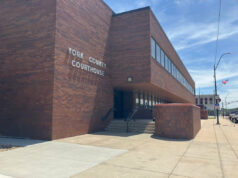Apr. 28: Spring Affair Plant Sale, 9 a.m.-2 p.m., Lancaster Event Center in Lincoln.
May 9: Introductory Level Field Scout Training, ENREC near Mead
May 21: Crop Science Investigation (CSI): In the field, 5-6 p.m., RSVP jrees2@unl.edu
May 22-23: Tractor Safety Training, Fairgrounds, Geneva, (402) 759-3712
May 24-25: Tractor Safety Training, Fairgrounds, Hastings, (402) 461-7209
May 29-30: Tractor Safety Training, Fairgrounds, Kearney, (308) 236-1235
May 30: Southeast NE Wheat Variety Tour
Planting Considerations: This email newsletter reaches a wide area of the State, so soil temps vary quite a bit and some of you may be in better planting conditions than others. We still recommend planting into soil temps as close to 50°F as possible, check weather conditions for next 48 hours to hopefully maintain temps 50°F or higher, and avoid saturated soil conditions. If planting a few degrees less than 50°F, make sure to check with seed dealers on more cold-tolerant seed. This is most likely common sense, but I still feel worth mentioning. Everything we do at planting sets the stage for the rest of the year. We’re blessed to have equipment that can allow for many acres to be planted in a short amount of time. And…we also have the ability to mess up a lot of acres in a short amount of time.
Planting depth is also key. Aim to get corn and soybean in the ground 1.5-2” deep. This is critical for correct root establishment in corn to avoid rootless corn syndrome. Rootless corn syndrome is when the nodal (crown) roots don’t get well established and successive brace roots can’t establish either. This allows the seedling to whip around in the wind, potentially being dislodged, become weak or die. With center-fill planters, when adjusting down-pressure on the go, sometimes the planter ends may not always be seeding as deep as the center. Too often I’ve seen that resulting in seed 1” or less and the field pattern can be observed the entire growing season with potential yield impacts. So don’t just rely on the monitor. Take the time to dig up seed behind the planter and at spots along the whole planter length to ensure the proper seeding depth. And do this with every field, particularly with different tillage/residue situations. I realize this takes time, but you’ll be glad you did to catch any issues before too many acres are planted incorrectly.
With cold temps or higher soil moisture conditions, it’s still important to get that seed at least 1.5-2” in the ground. Planting 1.5-2” deep helps both corn and soybean to have that seed in even soil temperature and moisture conditions. You may be surprised on that recommendation for soybean, but I think it’s even more critical with planting early. In fact, UNL research near Mead compared planting depths of 1.0, 1.25, 1.5, 1.75, 2.0, 2.25, and 2.5 inches in 2011 and an additional planting depth of 2.75 inches was added in 2012 and 2013. The study found lowest yields when soybean was planted 1.25” or less or 2.25” or greater with the highest yield at 1.75” deep. One of that study’s hypotheses was that planting deeper would buffer soil temperature and moisture and protect newly emerged seedlings from frost and freeze damage, particularly when planting early in the season.
Hopefully planting soybean early is still something you’re considering for this year! We wrote a CropWatch article this week at http://cropwatch.unl.edu to provide some updated research on amplifying the effects of planting early. There’s so much research regarding how early soybean planting increases yield that we wanted to share new research regarding maturity groups, etc. Essentially, what it appears from the research thus far, is that it’s more important to choose a consistent, high-yielding soybean for your area, regardless of specific maturity group. We’d like to get more specific data and have on-farm research protocols available to compare MG2.4-2.5 vs. MG3.0-3.5 and Dr. Jim Specht would also like to collaborate with us on documenting various factors. Please let me know if you’re interested in this! There’s also a protocol for comparing early vs. late planting of soybean.
Soil moisture conditions didn’t improve this week at the six sites I’m monitoring in Webster, Nuckolls, Thayer, and Clay counties. You can find the chart comparisons on my blog at http://jenreesources.com. Last weekend’s bizzard didn’t provide significant moisture in this area. With pastures slow with growth and drought increasing in Kansas, discussions with farmers have included cover crop termination, grazing rye that’s had anhydrous ammonia applied to it (with the original intention of termination and planting to corn), and grazing wheat. Most of these topics are included in this week’s UNL CropWatch at http://cropwatch.unl.edu. The articles are too long with too many considerations for me to add them in this news column, so please do check them out if you’re interested in these topics. Another topic I’ve had several questions about is regarding how temperature and rain affect burndown herbicide applications. Dr. Amit Jhala, Extension Weed Specialist, addresses that in this week’s CropWatch as well, so please check that out. Here’s wishing everyone a safe planting season with conditions to get #plant18 and #grow18 started off well!



































